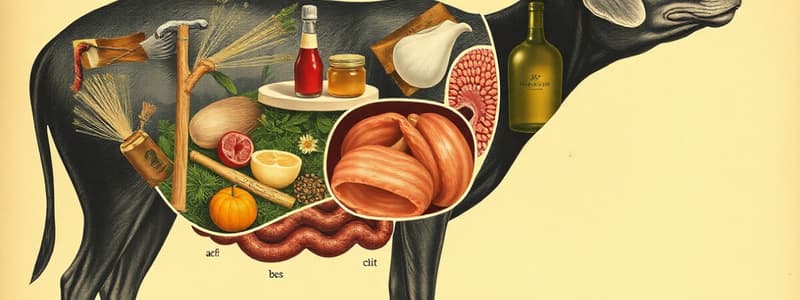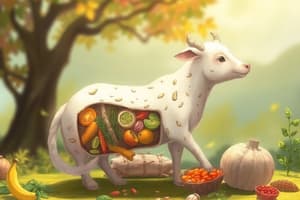Podcast
Questions and Answers
What is the primary role of mechanical digestion in the initial stages of food processing?
What is the primary role of mechanical digestion in the initial stages of food processing?
- To transport nutrients into the bloodstream.
- To eliminate undigested waste materials.
- To increase the surface area of food for chemical digestion. (correct)
- To enzymatically break down food molecules.
The primary function of the large intestine is nutrient absorption.
The primary function of the large intestine is nutrient absorption.
False (B)
What enzyme, present in saliva, begins the chemical digestion of carbohydrates in the mouth?
What enzyme, present in saliva, begins the chemical digestion of carbohydrates in the mouth?
amylase
The wave-like muscle contractions that move food through the digestive tract are known as ________.
The wave-like muscle contractions that move food through the digestive tract are known as ________.
Match the following digestive organs with their primary functions:
Match the following digestive organs with their primary functions:
Which of the following best describes the role of bile salts in fat digestion?
Which of the following best describes the role of bile salts in fat digestion?
Essential nutrients are synthesized by the body in sufficient quantities to meet physiological needs.
Essential nutrients are synthesized by the body in sufficient quantities to meet physiological needs.
What is the name of the inactive enzyme precursor secreted by chief cells in the stomach, which is later activated by hydrochloric acid?
What is the name of the inactive enzyme precursor secreted by chief cells in the stomach, which is later activated by hydrochloric acid?
The ______ portal vein carries absorbed nutrients directly to the liver for processing.
The ______ portal vein carries absorbed nutrients directly to the liver for processing.
Match each vitamin with its primary function or deficiency:
Match each vitamin with its primary function or deficiency:
Which part of the alimentary canal is primarily responsible for the absorption of nutrients?
Which part of the alimentary canal is primarily responsible for the absorption of nutrients?
Herbivores consume both plants and animals for their nutritional needs.
Herbivores consume both plants and animals for their nutritional needs.
What is the primary role of the epiglottis during swallowing?
What is the primary role of the epiglottis during swallowing?
The mixture of partially digested food and gastric secretions in the stomach is called ________.
The mixture of partially digested food and gastric secretions in the stomach is called ________.
Match the following enzymes with their substrates:
Match the following enzymes with their substrates:
Which vitamin is essential for the synthesis of collagen and also acts as an antioxidant?
Which vitamin is essential for the synthesis of collagen and also acts as an antioxidant?
Digestion is the process by which nutrients enter the bloodstream and cells.
Digestion is the process by which nutrients enter the bloodstream and cells.
What is the role of bicarbonate in the pancreatic juice that enters the small intestine?
What is the role of bicarbonate in the pancreatic juice that enters the small intestine?
_______ are muscle rings that act like doors to regulate the movement of food through the alimentary canal.
_______ are muscle rings that act like doors to regulate the movement of food through the alimentary canal.
Match the following terms with their descriptions regarding nutrition:
Match the following terms with their descriptions regarding nutrition:
Flashcards
Digestion
Digestion
Breaking food into smaller pieces, both mechanically (chewing) and chemically (enzymes via hydrolysis).
Peristalsis
Peristalsis
Wave-like muscle contractions that push food through the digestive tract.
Sphincters
Sphincters
Muscle rings that control the passage of food between different parts of the digestive tract.
Amylase
Amylase
Signup and view all the flashcards
Bolus
Bolus
Signup and view all the flashcards
Mucus Cells
Mucus Cells
Signup and view all the flashcards
Parietal Cells
Parietal Cells
Signup and view all the flashcards
Chief Cells
Chief Cells
Signup and view all the flashcards
Pepsin
Pepsin
Signup and view all the flashcards
Chyme
Chyme
Signup and view all the flashcards
Villi & Microvilli
Villi & Microvilli
Signup and view all the flashcards
Bile Salts
Bile Salts
Signup and view all the flashcards
Large Intestine (Colon)
Large Intestine (Colon)
Signup and view all the flashcards
Hepatic Portal Vein
Hepatic Portal Vein
Signup and view all the flashcards
Herbivores
Herbivores
Signup and view all the flashcards
Carnivores
Carnivores
Signup and view all the flashcards
Omnivores
Omnivores
Signup and view all the flashcards
Essential Nutrients
Essential Nutrients
Signup and view all the flashcards
Essential Vitamins
Essential Vitamins
Signup and view all the flashcards
Vitamin C
Vitamin C
Signup and view all the flashcards
Study Notes
- All animals are heterotrophs, meaning they must consume food for energy.
4 Stages of Food Processing
- Ingestion: The act of eating food.
- Digestion: The breakdown of food into smaller, absorbable pieces.
- Mechanical digestion: Physical breakdown, like chewing, to increase surface area.
- Chemical digestion: Using enzymes to break down food molecules through hydrolysis.
- Absorption: Nutrients entering the bloodstream and cells.
- Elimination: Removal of undigested waste (feces).
How the Body Avoids Self-Digestion
- Digestion occurs within specialized compartments like the stomach and intestines.
Types of Digestion
- Single-celled organisms: Utilize food vacuoles and lysosomes for digestion.
- Multicellular organisms: Employ extracellular digestion (outside cells).
- Small animals: Use a gastrovascular cavity (single opening for entry/exit).
- Large animals: Use an alimentary canal (two openings – mouth & anus).
Alimentary Canal (Human Digestive Tract)
- Accessory organs:
- Three pairs of salivary glands.
- Pancreas.
- Liver and gallbladder.
- Key movements:
- Peristalsis: Wave-like muscle contractions that propel food along the tract.
- Sphincters: Muscular rings that control the passage of food between compartments.
Steps in Digestion
- Oral cavity (mouth):
- Mechanical digestion: Teeth chew food, increasing surface area.
- Tongue: Forms a bolus (ball of food) for swallowing.
- Saliva:
- Amylase: Initiates starch breakdown.
- Mucus: Lubricates food for easier swallowing.
- The bolus goes to pharynx (throat) and then to the esophagus during swallowing.
- The epiglottis prevents food from entering the trachea (windpipe).
- Esophagus:
- Transports food to the stomach via peristalsis.
- Stomach:
- Highly expandable (can hold up to 2 liters).
- Primarily digests proteins.
- Gastric glands in the stomach lining contain:
- Mucus cells: Protect the stomach lining from acid.
- Parietal cells: Produce hydrochloric acid (HCl).
- Chief cells: Secrete pepsinogen (inactive form of pepsin).
- HCl activates pepsinogen into pepsin, which breaks down proteins into smaller polypeptides.
- Food mixes with HCl and pepsin, creating chyme.
- Chyme exits the stomach through the pyloric sphincter and enters the small intestine.
- Small intestine (SI):
- Approximately 6 meters long.
- Main site for nutrient absorption.
- Villi and microvilli line the small intestine to increase surface area for absorption.
- Receives secretions from:
- Pancreas: Delivers pancreatic juice (enzymes and bicarbonate).
- Liver: Provides bile (stored in the gallbladder) via the bile duct.
- Sections of the small intestine include:
- Duodenum: Primarily responsible for digestion.
- Jejunum and Ileum: Primarily responsible for absorption.
Nutrient Digestion Breakdown
- Carbohydrates:
- Digestion begins in the mouth with amylase and finishes in the small intestine.
- Proteins:
- Digestion starts in the stomach with pepsin and continues in the small intestine with trypsin and chymotrypsin.
- Nucleic acids (DNA/RNA):
- Digestion occurs only in the small intestine, using enzymes from the pancreas and intestine.
- Fats (lipids):
- Bile salts emulsify fats into smaller droplets.
- Pancreatic lipase digests fats into glycerol and fatty acids.
Absorption
- Takes place in the small intestine.
- Nutrients move into the blood (capillaries) or lymph (lacteal).
- Transport mechanisms include:
- Simple diffusion for water.
- Facilitated diffusion for fructose.
- Active transport for ions.
- Fats:
- After absorption, fats are reassembled, packaged into chylomicrons, and transported through the lymph system before entering the bloodstream.
Large Intestine (Colon)
- Chyme enters from the small intestine via the ileocecal valve.
- Primary function: Water absorption.
- Four sections: Ascending, transverse, descending, and sigmoid.
- Contains beneficial bacteria.
- Produces vitamins: K, B12, thiamine, and riboflavin.
- Waste becomes feces (about 75% water) and is eliminated through the anus.
Liver Functions
- Processes nutrients and synthesizes new compounds.
- Detoxifies drugs and alcohol.
- Stores excess glucose as glycogen.
- The hepatic portal vein transports absorbed nutrients directly to the liver.
What is Nutrition?
- Food provides:
- Energy (ATP).
- Building blocks for the body.
- Essential nutrients (those the body cannot synthesize).
Feeding Types
- Herbivores: Consume plants.
- Carnivores: Consume animals.
- Omnivores: Consume both plants and animals.
- Opportunistic feeders: Consume whatever is available.
Energy Needs
- Energy is measured in Calories (kcal), where 1 kcal = 1000 calories.
- Energy content per gram:
- Carbohydrates: 4 Calories.
- Protein: 4 Calories.
- Fat: 9 Calories.
Essential Nutrients
- Essential amino acids:
- 20 total, humans must obtain 8 from their diet (infants require 9).
- Essential fatty acids:
- Examples include linoleic and linolenic acid (found in seeds and vegetables).
- Essential vitamins:
- Act as coenzymes to aid enzyme function.
Vitamins Overview
- Water-soluble (not stored):
- B Vitamins (energy metabolism):
- B3 (niacin) → NAD/NADP.
- B9 (folic acid) → essential during pregnancy for neural tube development.
- B12 → needed for red blood cell production (found only in animal products).
- Vitamin C:
- Involved in collagen synthesis.
- Acts as an antioxidant.
- Enhances iron absorption.
- Deficiency leads to scurvy.
- Fat-soluble (stored in fat):
- Vitamin A: Critical for vision (retinal synthesis).
- Vitamin D: Facilitates calcium absorption.
- Deficiency can cause rickets in children and osteomalacia in adults.
Studying That Suits You
Use AI to generate personalized quizzes and flashcards to suit your learning preferences.




